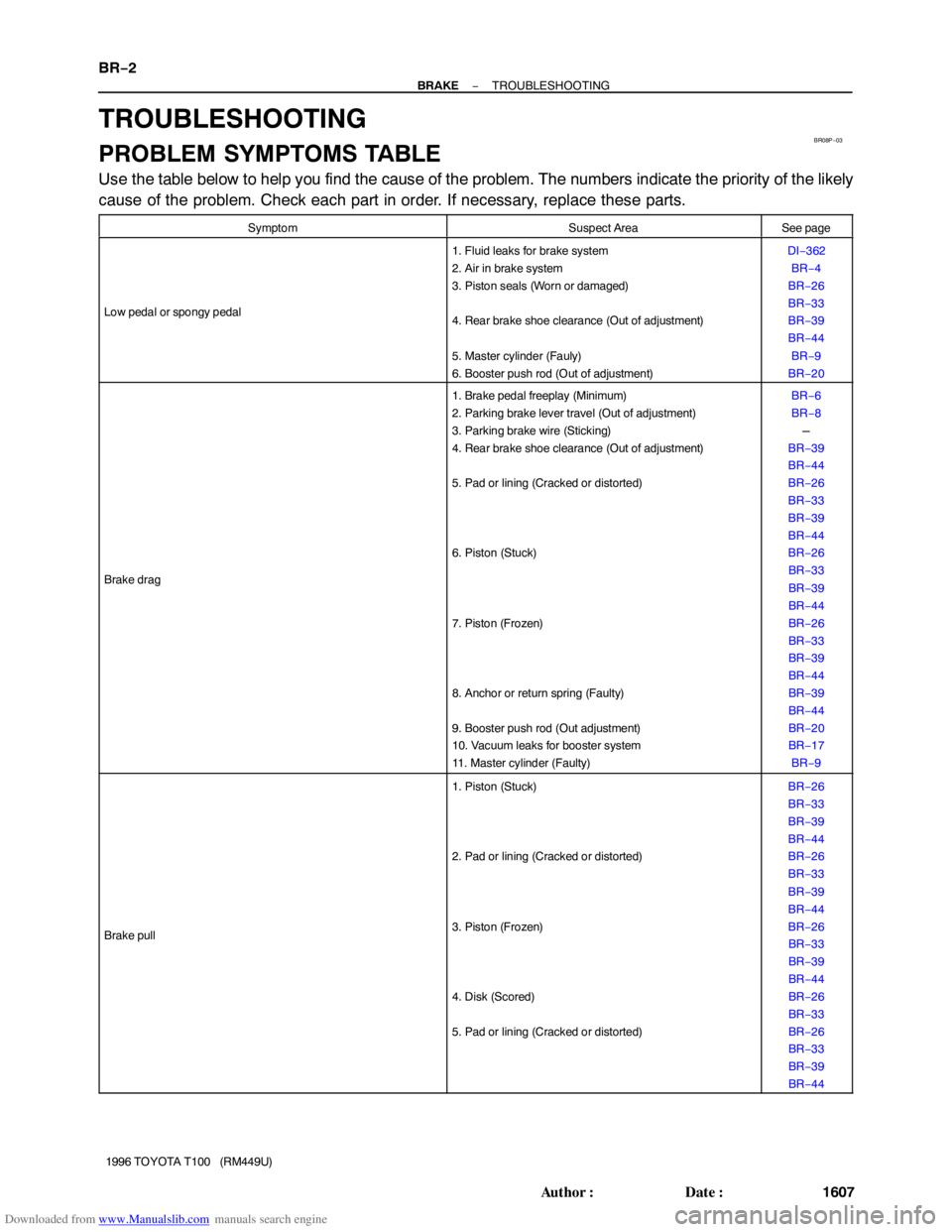Page 1613 of 2062
Downloaded from www.Manualslib.com manuals search engine R04328
R12920
SST
SST
RA0997
− SUSPENSION AND AXLEREAR DIFFERENTIAL CARRIER
SA−143
1996 TOYOTA T100 (RM449U)
14. CHECK DIFFERENTIAL CASE RUNOUT
(a) Install the differential case in the differential carrier (See
page SA−145).
(b) Using a dial indicator, measure the differential case run-
out.
Maximum case runout: 0.04 mm (0.0016 in.)
(c) Remove the differential case.
15. REMOVE SIDE BEARINGS
Using SST, remove the 2 side bearings from the differential
case.
SST 09950−40010, 09950−60010 (09951−00450)
HINT:
Fix the claws of SST to the notch in the differential case.
16. DISASSEMBLE DIFFERENTIAL CASE ASSEMBLY
(a) Using a pin punch and hammer, remove the straight pin.
(b) Remove these parts from the differential case:
�Pinion shaft
�2 pinion gears
�2 pinion gear thrust washers
�2 side gears
�2 side gear thrust washers
Page 1617 of 2062

Downloaded from www.Manualslib.com manuals search engine R00055
SST
R11163SST
SA2351
SST
SA2446
− SUSPENSION AND AXLEREAR DIFFERENTIAL CARRIER
SA−147
1996 TOYOTA T100 (RM449U)
HINT:
First fit a washer with the same thickness as the washer which
was removed, then after checking the tooth contact pattern, re-
place the washer with one of a different thickness if necessary.
6. INSTALL DRIVE PINION REAR BEARING
Using SST and a press, install the rear bearing onto the drive
pinion.
SST 09506−35010
7. TEMPORARILY ADJUST DRIVE PINION PRELOAD
(a) Install the drive pinion and front bearing.
HINT:
Assemble the spacer, washers and oil seal after adjusting the
gear contact pattern.
(b) Using SST, install the companion flange.
SST 09950−30010
(c) Coat the threads of the nut with hypoid gear oil.
(d) Adjust the drive pinion preload by tightening the compan-
ion flange nut.
Using SST to hold the flange, torque the nut.
SST 09330−00021
NOTICE:
As there is no spacer, tighten the nut a little at a time, being
careful not to overtighten it.
(e) Using a torque wrench, measure the preload.
Preload (at starting):
New bearing:
1.0 − 1.6 N·m (10 − 16 kgf·cm, 8.7 − 13.9 in.·lbf)
Reused bearing:
0.5 − 0.8 N·m (5 − 8 kgf·cm, 4.3 − 6.9 in.·lbf)
Page 1619 of 2062

Downloaded from www.Manualslib.com manuals search engine R04338
R04456
RA0090
R04456
− SUSPENSION AND AXLEREAR DIFFERENTIAL CARRIER
SA−149
1996 TOYOTA T100 (RM449U)
(f) Remove the plate washers and differential case.
(g) Install the plate washer into the ring gear back side of the
carrier.
(h) Place the other plate washer onto the differential case to-
gether with the outer race, and install the differential case
with the outer race into the carrier.
(i) Tap on the ring gear with a plastic hammer so that the
washer fit to the bearing.
(j) Using a dial indicator, measure the ring gear backlash.
Backlash:
2WD: 0.08 − 0.13 mm (0.0031 − 0.0051 in.)
4WD: 0.13 − 0.18 mm (0.0051 − 0.0071 in.)
(k) If the backlash not within specification, adjust by either in-
creasing or decreasing the thickness of washers on both
sides by an equal amount.
HINT:
�There should be no clearance between the plate washer
and case.
�Make sure that there is ring gear backlash.
10. ADJUST SIDE BEARING PRELOAD
(a) After adjustment with the backlash as reference, remove
the ring gear teeth side plate washer and measure the
thickness.
(b) Install a new washer of 0.06 − 0.09 mm (0.00024 − 0.0035
in.) thicker than the washer removed.
HINT:
Select a washer which can be pressed in 2/3 of the way by fin-
ger.
(c) Using a plastic hammer, tap in the plate washer.
(d) Recheck the ring gear backlash.
Backlash:
2WD: 0.08 − 0.13 mm (0.0031 − 0.0051 in.)
4WD: 0.13 − 0.18 mm (0.0051 − 0.0071 in.)
(e) If the backlash is not within specification, adjust by either
increasing or decreasing the thickness washers on both
sides by equal amount.
HINT:
The backlash will change by about 0.20 mm (0.0008 in.) with
every 0.03 mm (0.0012 in.) change in the side washer.
Page 1623 of 2062
Downloaded from www.Manualslib.com manuals search engine SA2351
SST
− SUSPENSION AND AXLEREAR DIFFERENTIAL CARRIER
SA−153
1996 TOYOTA T100 (RM449U)
Torque: 451 N·m (4,600 kgf·cm, 333 ft·lbf) or less
If the maximum torque is exceeded with retightening the nut, re-
place the bearing spacer and repeat the preload adjusting pro-
cedure. Do not loosen the pinion nut to reduce the preload.
20. INSTALL DIFFERENTIAL CASE IN CARRIER (See
page SA−145)
21. RECHECK TOTAL PRELOAD (See page SA−145)
22. RECHECK RING GEAR BACKLASH (See page
SA−145)
23. RECHECK TOOTH CONTACT BETWEEN RING GEAR
AND DRIVE PINION (See page SA−145)
24. CHECK RUNOUT OF COMPANION FLANGE (See
page SA−140)
25. STAKE DRIVE PINION NUT
Page 1627 of 2062
Downloaded from www.Manualslib.com manuals search engine SA0IA−01
RA0851
− SUSPENSION AND AXLEREAR SHOCK ABSORBER
SA−157
1996 TOYOTA T100 (RM449U)
INSPECTION
INSPECT SHOCK ABSORBER
Compress and extend the shock absorber rod and check that
there is no abnormal resistance or unusual operation sounds.
If there is any abnormality, replace the shock absorber with a
new one.
NOTICE:
When discarding the shock absorber, use the following
procedure.
Page 1639 of 2062

Downloaded from www.Manualslib.com manuals search engine BR08P−03
BR−2
− BRAKETROUBLESHOOTING
1607 Author�: Date�:
1996 TOYOTA T100 (RM449U)
TROUBLESHOOTING
PROBLEM SYMPTOMS TABLE
Use the table below to help you find the cause of the problem. The numbers indicate the priority of the likely
cause of the problem. Check each part in order. If necessary, replace these parts.
SymptomSuspect AreaSee page
Low pedal or spongy pedal
1. Fluid leaks for brake system
2. Air in brake system
3. Piston seals (Worn or damaged)
4. Rear brake shoe clearance (Out of adjustment)
5. Master cylinder (Fauly)
6. Booster push rod (Out of adjustment)DI−362
BR−4
BR−26
BR−33
BR−39
BR−44
BR−9
BR−20
Brake drag
1. Brake pedal freeplay (Minimum)
2. Parking brake lever travel (Out of adjustment)
3. Parking brake wire (Sticking)
4. Rear brake shoe clearance (Out of adjustment)
5. Pad or lining (Cracked or distorted)
6. Piston (Stuck)
7. Piston (Frozen)
8. Anchor or return spring (Faulty)
9. Booster push rod (Out adjustment)
10. Vacuum leaks for booster system
11. Master cylinder (Faulty)BR−6
BR−8
�
BR−39
BR−44
BR−26
BR−33
BR−39
BR−44
BR−26
BR−33
BR−39
BR−44
BR−26
BR−33
BR−39
BR−44
BR−39
BR−44
BR−20
BR−17
BR−9
Brake pull
1. Piston (Stuck)
2. Pad or lining (Cracked or distorted)
3. Piston (Frozen)
4. Disk (Scored)
5. Pad or lining (Cracked or distorted)BR−26
BR−33
BR−39
BR−44
BR−26
BR−33
BR−39
BR−44
BR−26
BR−33
BR−39
BR−44
BR−26
BR−33
BR−26
BR−33
BR−39
BR−44
Page 1641 of 2062

Downloaded from www.Manualslib.com manuals search engine R12874
BR08Q−01
R12851
R12852
Z03605
BR−4
− BRAKEBRAKE FLUID
1609 Author�: Date�:
1996 TOYOTA T100 (RM449U)
BRAKE FLUID
BLEEDING
HINT:
If any work is done on the brake system or if air is suspected in
the brake lines, bleed the system of air.
NOTICE:
Do not let brake fluid remain on a painted surface. Wash it
off immediately.
1. FILL BRAKE RESERVOIR WITH BRAKE FLUID
Check the fluid level in the reservoir after bleeding each wheel.
Add fluid, if necessary.
2. BLEED MASTER CYLINDER
HINT:
If the master cylinder was disassembled or if the reservoir be-
comes empty, bleed the air from the master cylinder.
(a) Disconnect the brake lines from the master cylinder.
(b) Slowly depress the brake pedal and hold it.
(c) Block off the outlet plug with your finger, and release the
brake pedal.
(d) Repeat (b) and (c) 3 or 4 times.
3. CONNECT VINYL TUBE TO WHEEL CYLINDER
BLEEDER PLUG
Insert the other end of the tube in a half−full container of brake
fluid.
HINT:
Begin air bleeding from the wheel cylinder with the longest hy-
draulic line.
4. BLEED BRAKE LINE
(a) Slowly depress the brake pedal several times.
Page 1643 of 2062

Downloaded from www.Manualslib.com manuals search engine BR3295
Stop Light Switch
Pedal Height Push RodBR08R−01
BR4980
A BR−6
− BRAKEBRAKE PEDAL
1611 Author�: Date�:
1996 TOYOTA T100 (RM449U)
BRAKE PEDAL
ON−VEHICLE INSPECTION
1. CHECK PEDAL HEIGHT
Pedal height from asphalt sheet:
Extra cab 4WD:
146.7 − 156.7 mm (5.776 − 6.169 in.)
Except extra cab 4WD:
149.7 − 159.7 mm (5.894 − 6.287 in.)
2. IF NECESSARY, ADJUST PEDAL HEIGHT
(a) Disconnect the connector from the stop light switch.
(b) Loosen the stop light switch lock nut and remove the stop
light switch.
(c) Loosen the push rod lock nut.
(d) Adjust the pedal height by turning the pedal push rod.
(e) Tighten the push rod lock nut.
Torque: 25 N·m (260 kgf·cm, 19 ft·lbf)
(f) Install the stop light switch and turn it until it lightly con-
tacts the pedal stopper.
(g) Turn the stop light switch back one turn.
(h) Check the clearance (A) between stop light switch and
pedal.
Clearance: 0.5 − 2.4 mm (0.020 − 0.094 in.)
(i) Tighten the stop light switch lock nut.
(j) Check the stop lights come on when the brake pedal is de-
pressed, and go off when the brake pedal is released.
(k) After adjusting the pedal height, check the pedal freeplay.
HINT:
If clearance (A) between the stop light switch and the pedal
stopper has been adjusted correctly, the pedal freeplay will
meet the specifications.